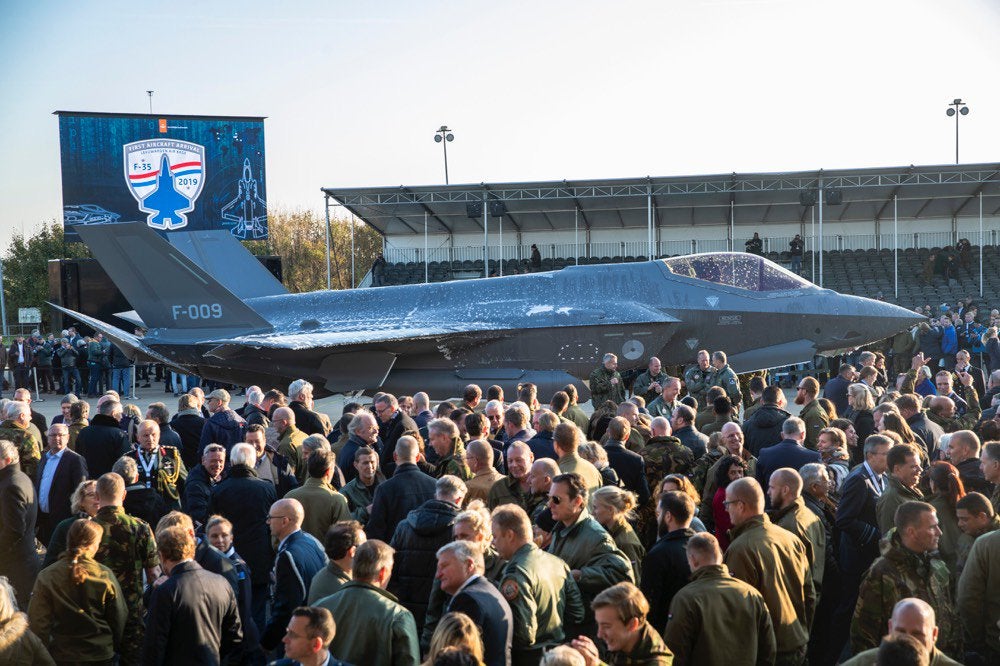Royal Netherlands Air Force Receives First Netherlands-Based F-35
On 31 October, the Royal Netherlands Air Force (RNLAF) received its first Netherlands-based F-35A at Leeuwarden Air Base. The F-35A, tail number F-009, landed at 1530 local time after performing a lap of the air base accompanied by two RNLAF F-16s, a Hawker Hunter and a Supermarine Spitfire. F-009 was piloted by Lieutenant Colonel Ian Knight, the commanding officer of the RNLAF’s 323 Test & Evaluation Squadron.

The RNLAF currently operates eight other F-35As, but those F-35As are currently in the United States, where two are used for testing at Edwards Air Force Base in California and the remaining six are used for pilot training at Luke Air Force Base in Arizona. Several of the United States-based F-35As have visited the Netherlands, but F-009 will be the first F-35A to be permanently based in the Netherlands. F-009 is also the first RNLAF F-35 to be built at Leonardo’s F-35 FACO (Final Assembly and Check Out) facility in Cameri, Italy.

The entirety of F-009’s arrival was streamed online by the Dutch Ministry of Defence. The ceremony was attended by over 2,000 guests, including the Dutch Minister of Defence, Ank Bijleveld and the State Secretary of Defence, Barbara Visser. The Commander of the Royal Netherlands Air Force, Lieutenant General Dennis Luyt and the commandant of Leeuwarden Air Force Base, Colonel Arnoud Stallmann, were in attendance as well.
In her speech at the ceremony, Visser stated:
A little over 40 years ago, the first Dutch F-16 was welcomed here. It was called ‘the aircraft of the future’. While the F-16 used a computer-controlled operating system for the first time, computers and software play such a major role with the F-35 that it is sometimes called a flying laptop. That means a huge change in our work.
A water cannon salute originally intended to be part of the ceremony instead became a firefighting foam salute. However, this did not impede the ceremony. According to the Ministry of Defence, the fire trucks used had been called to attend to an emergency landing of an RNLAF F-16, and their crews forgot to reset the hoses to dispense water instead of foam. Amateur radio operators report that the F-16 in question made an emergency landing at Leeuwarden Air Base after the pilot smelled fire in the cockpit.

Following its arrival, F-009 will be subject to further inspections expected to last two weeks. While the effects of the foam on the airframe have been hotly speculated by many publications, F-35 technicians reached for comment by Technical Weekly believe that there is little cause for concern. According to them, neither the aircraft or engine is damaged by such a bath, although a good cleaning is required like with an F-16.
The RNLAF plans to purchase 46 F-35s in total. These F-35s will completely replace the 60 F-16A MLUs currently in service with the RNLAF. The RNLAF hopes to achieve initial operating capacity for the F-35 in 2021 with the 322 Squadron. A second squadron located at Volkel Air Base is currently planned to be stood up in 2023.
Update 14 November: The RNLAF has stated to NOS that an inspection of F-009 has confirmed that it was undamaged by the foam, following remote inspection by both Lockheed Martin and Pratt & Whitney. The engine has been thoroughly rinsed, and the rest of the aircraft inspection and preparation is proceeding as planned.

